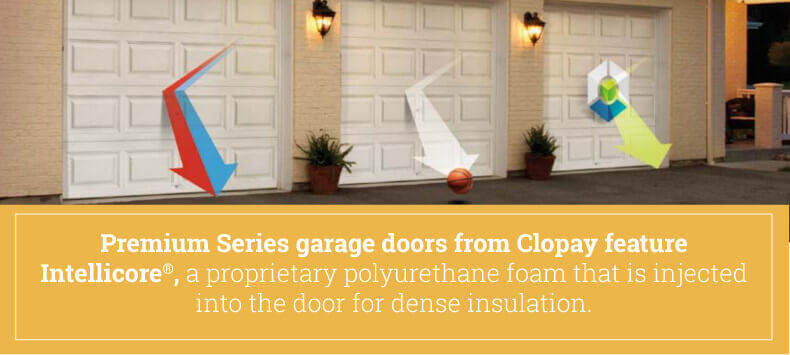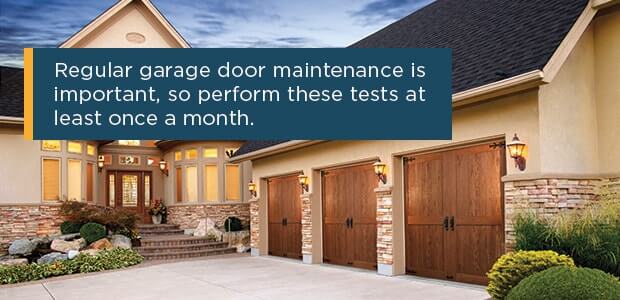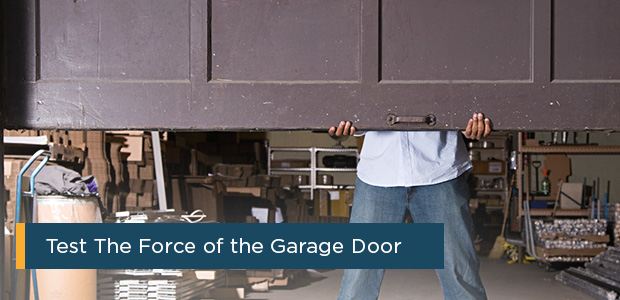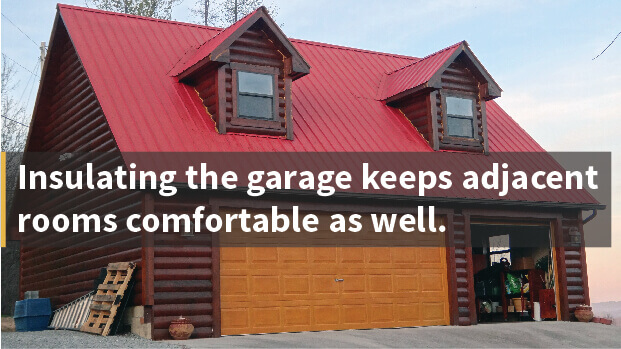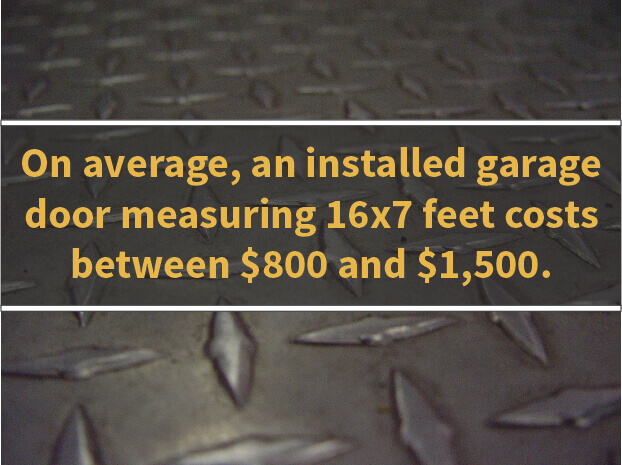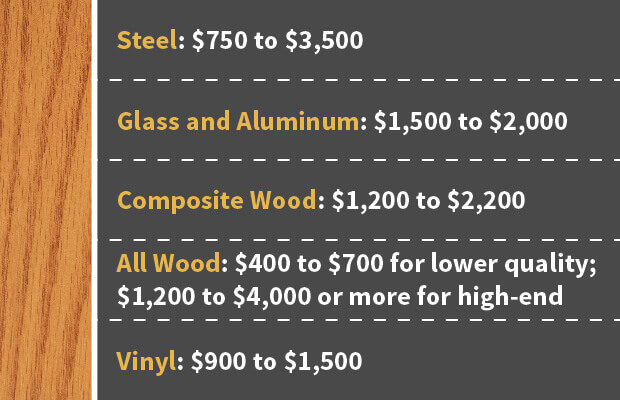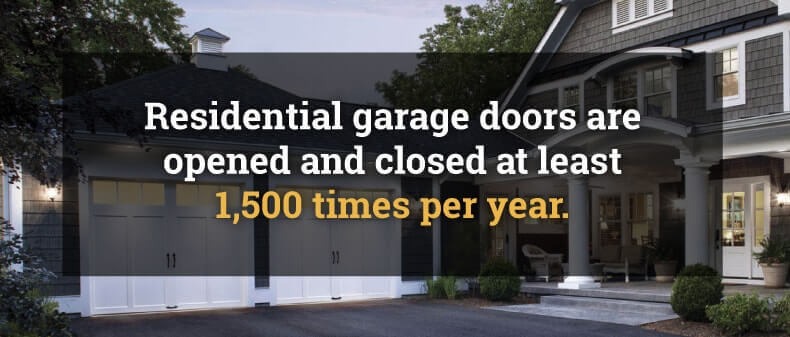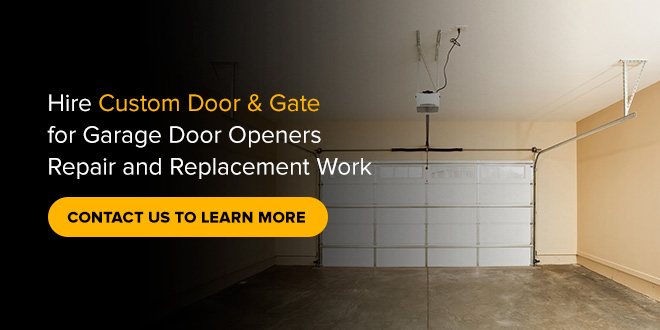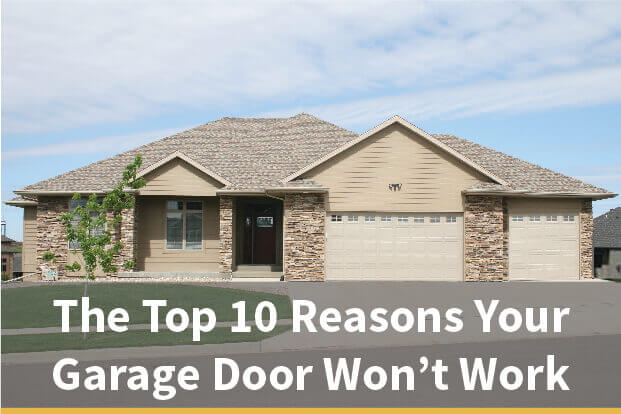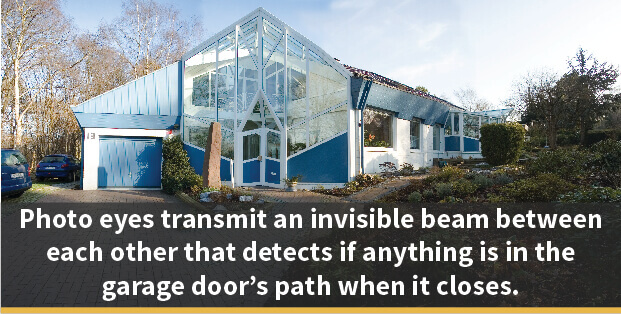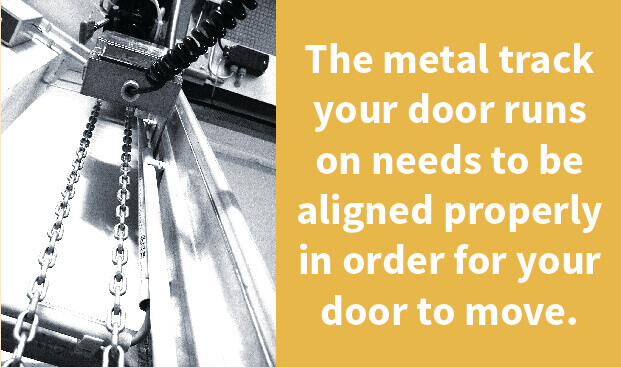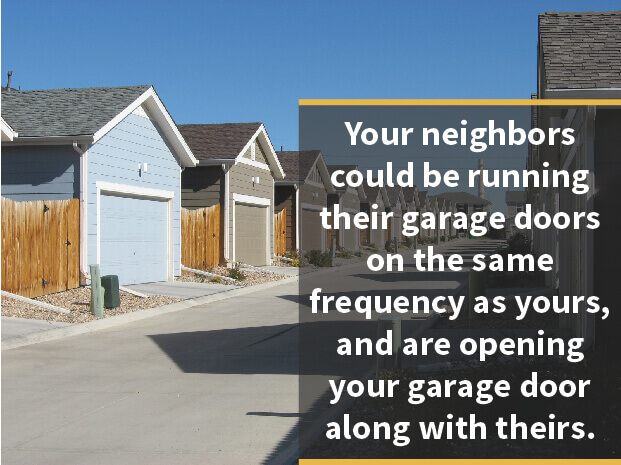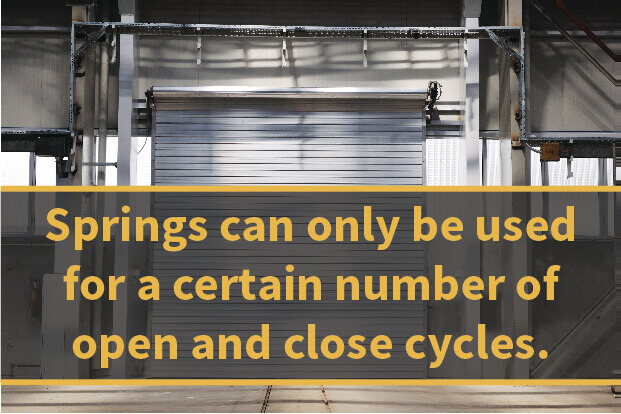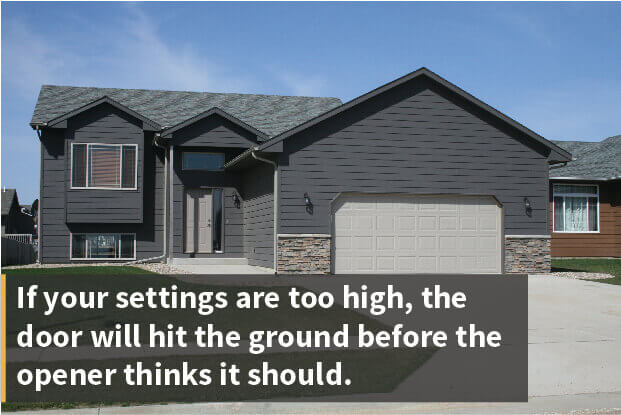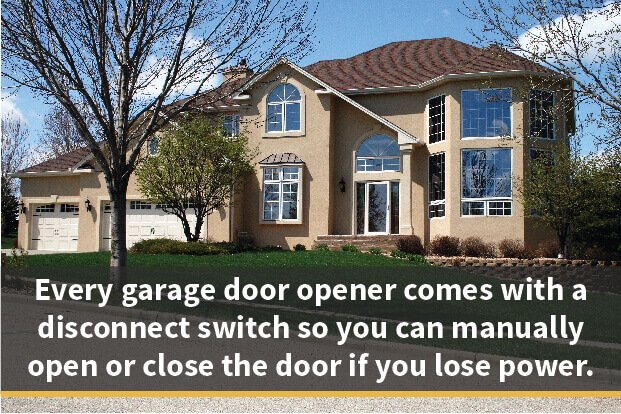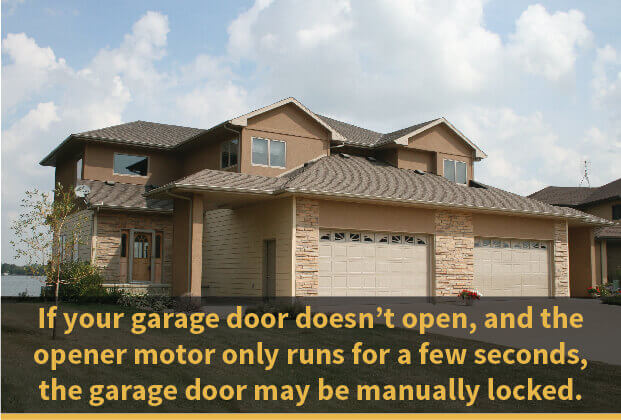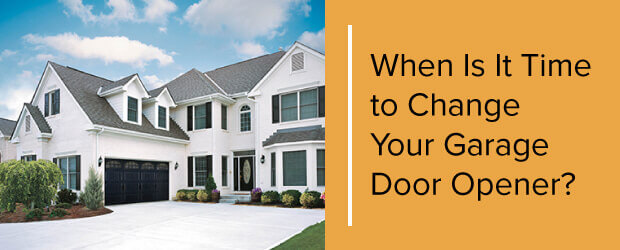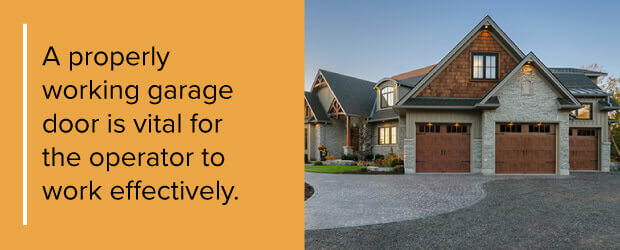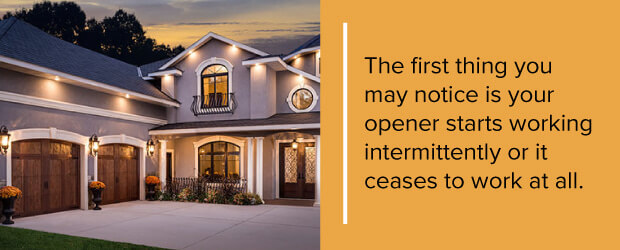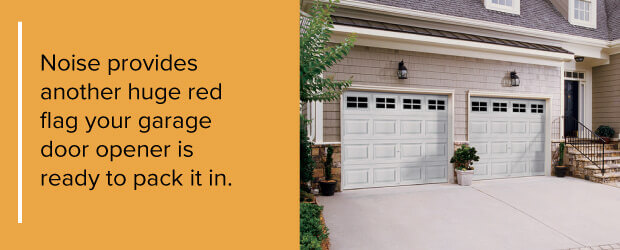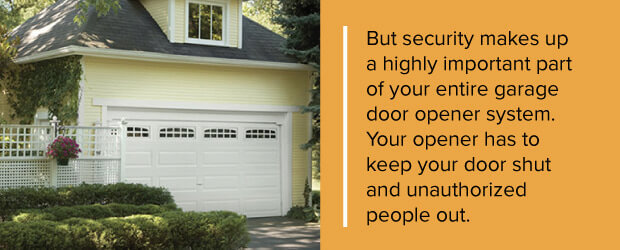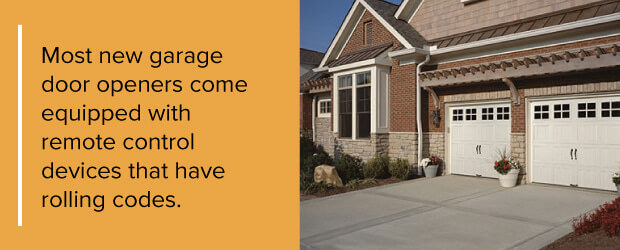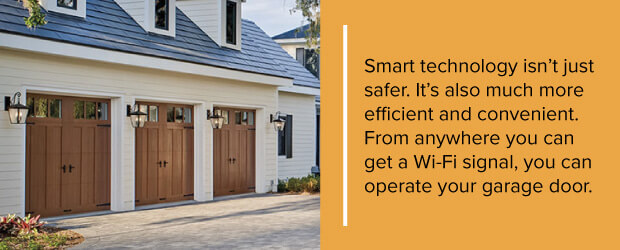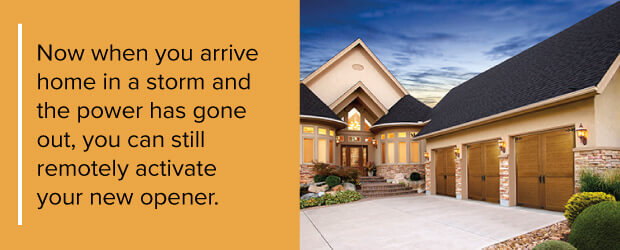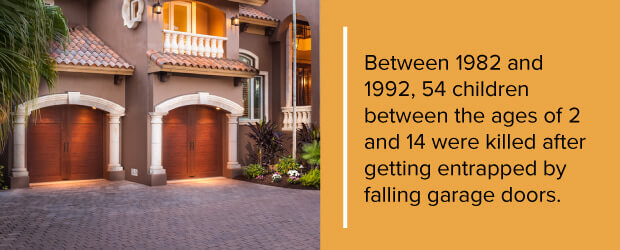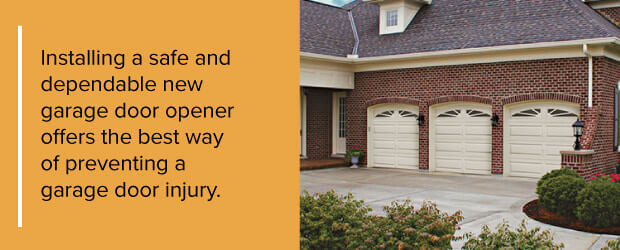Steel Garage Door Construction Types
When you decide to have new garage door installation performed on your home, it’s important to know about the various types of steel garage doors available on the market.
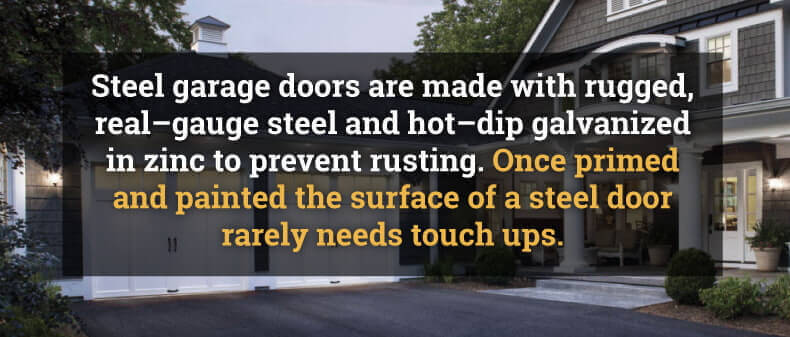
Steel doors are generally made with heavy–duty steel that requires little maintenance and come in three levels of strength — single, double and triple–layer. The respective qualities of the three levels are as follows:
- Single layer — sometimes referred to as “pan garage doors” — feature solid, durable exteriors that require little maintenance. Due to their thinness, however, single–layer steel doors can get dented when hit, and are generally ill–suited for wide garage door openings.
- Double layer — consists of one steel layer backed with polystyrene thermal insulation. Quieter and more durable than pan doors, the double–layer garage door is a low–maintenance, energy efficient and environmentally sound option.
- Triple layer — comprised of a steel front, thermal middle and steel back. Sometimes referred to as the “sandwich garage door,” the steel triple layer is the strongest and most durable of garage door options on the market. With heavy–duty material on the outside and inside, this low–maintenance door contains eco–friendly polystyrene thermal insides that can help boost a home’s energy efficiency. Furthermore, this conveniently soundproof door is quiet to open and shut.
Steel garage doors are made with rugged, real–gauge steel and hot–dip galvanized in zinc to prevent rusting. This is followed by a primer coat for additional surface strength, and finished with topcoat paint, for strong, lasting color. The surface of a steel door rarely needs touch ups.
Non–insulated, single–layer garage doors generally come in one of three gauges of thickness — 24, 25 and 26. The lower the number, the thicker the metal. The two–layer garage door is typically backed with a vinyl layer, which holds the insulation in place. Thicker doors have a better R–value, which is used for determining how well the door insulates its enclosure and thereby designating its energy-efficiency. The best type of steel garage door is the triple–layer steel back with at least two inches if thickness.
Many newer garage doors are reinforced with wind–load reinforcements, which are now required in several states, including California, Missouri and Nevada. Reinforced garage doors look the same as other doors, but are compliant with local building codes.
The Benefits of Single-layer Garage Doors
The single–layer steel garage door is an adequate choice for anyone looking for a simple and reliable door that can seal off a garage from the outside without buckling under harsh natural conditions.
#1. Light Weight
The most convenient thing about pan steel garage doors is that they’re relatively light weight, and therefore don’t require much mechanical or physical force to move up and down. If you opt not to have an electrically operable garage door setup, a single–layer door would be the easiest option to manage of all the steel garage door types. Granted, a manual–only garage door is most suitable for households where bikes or motorcycles, as opposed to cars or vans, are the preferred means of transportation, because it can be tedious to get out of a vehicle just to activate a door.

The lighter weight of a single layer garage door also means that there is less impact when it reaches the ground, and less weight to lift by hand. Therefore, if a garage door opening system fails, the problem is easier to rectify manually.
#2. Durable Surface
As with all steel garage doors, the single layer also boasts a strong surface, which makes it ideal for any type of climate. Whereas doors made of wood and vinyl can buckle under certain conditions, steel will hold its shape and surface quality throughout the coldest of winters and hottest of summers. Even in areas that see weeks on end of heavy downpour and harsh storms of snow and hail, steel is the most resilient material for a garage door surface.
The strength and durability of the steel surface stands in marked contrast to vinyl, which can get damaged in climates where extreme weather is a seasonal reality. Whereas the surface of a vinyl garage door can warp in the midst of excessively humid conditions, or become brittle and crack in freezing temperatures, the surface of steel simply warms and cools with no alteration of the composition.
The Benefits of Double-layer Garage Doors
Double–layer steel garage doors are a sensible option for homeowners who care about qualities like thermal protection, strength and durability in a garage door.
#1. Stronger
One of the most obvious benefits that double–layer steel garage doors have over pan doors is improved strength. It’s the layer of insulation that makes these doors thicker, which in turn makes them less prone to dents or easy damage. If your garage door sees lots of usage, minor accidents can and most likely will happen from time to time, such as when a flying ball or object hits the door. In order to keep a door protected against such an impact, it’s necessary to have more than just a thin layer of steel for a garage door.
Due to the additional strength of a double–layer door, problems such as bends, folds and cracks along the panel are less likely to occur, because the door is much more durable and therefore primed to handle years of operation. As such, any garage put to regular use — especially when the garage is attached to the house — should have a double–layer door at minimum.
#2. More Insulating
Double–layer garage doors are also more insulating than single–layer garage doors, which is a really important advantage for any residential property. If your garage is incorporated into the framework of your house, the door itself will serve as the single largest entryway into your home. Therefore, insulation is necessary to prevent air from passing in and out of the garage, because that same air will compromise the comfort of your living areas.
If your garage is separate from your house, it’s still best to have a door with insulation, because you won’t want the belongings within your garage to be overexposed to hot and cold weather cycles. Most of all, your car should not be parked overnight for weeks on end in a garage that has no thermal protection from the icy cold temperatures of December and January. Even if you only use this detached garage for storage or woodwork, the space and contents within will be best preserved with the insulation that a steel garage door with at least two layers can provide.
#3. Low Maintenance
A double–layer steel garage door is unlikely to need any maintenance over the course of time that you occupy a residency. Along the outer surface of a steel garage door, the paint is unlikely to chip, dent or wear away in any spot. Therefore, you won’t have to worry about matching a color to touch up spots or go through the trouble of repainting the entire door.
Garage doors of this type won’t rust either, which is even more important when you consider the nature of steel. On an uncoated piece of steel, rust is like kryptonite. Once it forms on a steel surface at any particular spot, it can spread to surrounding areas. The worst thing about rust is not that it diminishes the appearance of metal, but that it actually has the power to eat holes through the metals it infects. For obvious reasons, this would be a very dangerous condition for any garage door. Thankfully, double–layer steel garage doors are zinc–coated to prevent the possibility of rust.
The Benefits of Triple-layer Garage Doors
Triple–layer steel garage doors are the best option for homeowners looking for thermal comfort, durability, strength, longevity, quietness and energy efficiency in a garage door.
#1. Strength
Triple–layer models are the strongest option out of all the different types of steel garage doors, with a durability that can withstand the physical tests of time, weather, children and even cars. Even after years of continual use, you probably won’t need to paint the surfaces, seal gaps or replace any panels, because nothing is likely to come undone on a sandwich door. When you have a door with this level of strength and durability, the impacts of snow, hail and other harsh weather elements are non-issues.
If someone in your household enjoys shooting hoops in the driveway, there’s no need to worry about the door getting dented by hits from a basketball. If there are younger members of your household who play on bikes or tricycles and accidently run into the door, there’s little chance of the door even getting scraped, let alone dented. Even if you accidentally hit the door with the bumper of your vehicle while pulling into the driveway, a triple–layer door is usually strong enough to come out unscathed.
#2. Thermal Qualities
Out of all the garage door types on the market, triple–layer steel doors offer an unsurpassed level of thermal comfort. Whereas single–layer doors merely close off your house from intrusion, downpour and vehicle theft, triple–layer doors block the passage of heat and cold temperatures between the inside and outside of your home. This can be very beneficial when you consider how discomforting the weather can be at certain times of the year, especially now that seasonal shifts are becoming more and more extreme.
Premium Series garage doors from Clopay feature Intellicore® insulation technology. Intellicore® is a proprietary polyurethane foam that is injected into the door for dense insulation. The results are an industry leading R-Value of 18.4. During the summer, the twin layers of steel and the inner thermal protection will keep humidity out of your air conditioned home. Likewise, that same triple–layer design will block icy cold temperatures from seeping into your garage and diluting the warmth of your living space. As such, you won’t have to cope with harsh temperatures in discomforting ways, such as by wearing thick extra layers during the holidays and next to nothing during the middle of each year.
#3. Energy Efficiency
The thermal qualities of a garage door also relate to energy efficiency, which doors of the triple–layer steel variety offer in spades. When you don’t have to worry about compromised insulation, you can rest assured that your energy bills will stay at a minimum. When there’s no heat leaking out of your house in the winter, nor any AC breeze getting diluted by outdoor humidity, you don’t have to crank up your HVAC system to compensate.
A lot of homeowners don’t even realize the financial impact of weakened insulation in their homes. For example, the seals around a door or window might be compromised over time and ultimately lead to gaps that allow for the passage of air between the inside and outside. Gradually, a homeowner will unconsciously crank the HVAC high and higher to make up for the loss in insulation. Over time, this can lead to energy expenses that will exceed the cost of insulation maintenance.
As the largest entryway to your home, the insulation of your garage door is one of the most important qualities for the comfort and energy efficiency of your home.
#4. Quietness
Quietness as a feature doesn’t stand out to many homeowners when buying a new garage door, but it’s actually very important when you consider just how much noise a steel triple–layer can block from your home. Just as with your living room, where high–quality window panes and sills are necessary to prevent outside noise from interrupting your evenings, a thick garage door is necessary to block out the sound of rowdy neighbors and the roar of passing vehicles on your block of residence.
In fact, one of the biggest mistakes that a homeowner can make is to skimp with a thin garage door, without even considering the potential for noise intrusion. Once you’ve had too many dinners or nights by the fire interrupted by shouting neighbors and revved up engines, you ultimately come to realize that soundproofing is just as important as temperature insulation. Triple–layer steel doors have not just one, but two thick layers of steel to block out noise, in addition to a layer of insulation to prevent echoing.
Single-layer vs. Triple-layer
Pan doors can be dented by children running their bikes into the door, or when a ball hits the door during games of driveway basketball. Worse yet, a car might accidentally bump a pan door while pulling into the driveway and cause more serious damage. However, these same problems generally don’t occur with sandwich doors.
The two most common warning signs that a pan door is about to collapse is when the top panel comes undone from the surrounding frame when the door is shut, or when cracks appear in the top panel when the door is raised.
The price difference between a pan door and a sandwich door is roughly the same as the cost to replace a damaged panel on a pan door. A pan door can be purchased in insulated form, where a layer of insulation is added to the inside, but doesn’t add much strength overall.
Steel Doors vs. Wood Doors
Wooden garage doors are made of fine milled wood that gives them a timeless visual appeal. Well–crafted and intricate in detail, wooden doors are made in painted or stained varieties. The environmentally sound insulation within wooden doors is comprised of polystyrene, which can therefore boost a home’s energy efficiency.
Even though wood is environmentally sound and visually appealing, it’s not the strongest of materials for use on a garage door. Harsh seasons can take their toll on the surface of wood, which can untimely crack along areas that get hit, or develop mold formations on spots where coating rubs off.
Steel garage doors, by contrast, consist of stronger material that doesn’t crack or mold, and that comes in various sizes and colors.
Steel Doors vs. Vinyl Doors
Vinyl doors consist of laminated front panels and back surfaces, as well as steel and foam cores. Doors with vinyl surfaces are generally less expensive than wood doors, but costlier than steel garage doors.
However, vinyl is not the environmentally friendly garage door option. The material can warp on homes situated in regions with more extreme climates, and can also be rendered brittle by freezing temperatures. On the other hand, vinyl garage doors are good for homes built in coastal areas, because vinyl is resistant to air salt.
Some of the problems with vinyl have been rectified on newer garage doors, which are generally more reliable. Modern vinyl doors are made with C–channel steel reinforcement on each panel, and coated with polymers to resist ultraviolet rays.
Vinyl doors are produced in various colors, and the material provides better insulation than wood. Vinyl can also be made to look like various different types of wood. However, the look of wood is more authentically replicated with fiberglass.
Steel Doors vs. Aluminum Doors
Aluminum doors have a number of surface benefits, because the material is rustproof, low cost, low maintenance and lightweight. As such, aluminum garage doors are easy to operate. Tilt–up and single–piece aluminum doors are the lowest cost varieties. Insulated aluminum doors cost twice as much as single piece, but are reasonably priced compared to steel doors.
Glass–aluminum garage doors are made with a range of window options with light–blocking features. The material is rust–resistant, low maintenance and comes in various colors.
However, aluminum is not as strong as steel. Consequently, aluminum garage doors are likelier to dent. Furthermore, aluminum doors can render a home less energy efficient, because the material doesn’t block the flow of heat. Even though aluminum doors are enhanced with insulation, this is uncommon in most manufactured aluminum garage doors.
Steel garage doors, on the other hand, do not warp, dent or sag at the center. Steel doors can be also be soundproofed and insulated with foam, which is not possible with aluminum. While aluminum doors are a reliable, low–cost option for garages not attached to homes, and the material can be aesthetically attractive, aluminum is the ideal option for garages attached to homes.
Get a New Garage Door Installation from Custom Door & Gate
At Custom Door & Gate, we carry a range of Clopay steel garage door types in one–layer, three–layer and even four–layer varieties. Four–layer garage doors consist of twin steel exteriors with insulation at the center and a composite overlay. Clopay steel doors are available in several colors, including almond and sandstone. The doors are designed in flat top and arched varieties, and feature insulation layers with two options of thickness. We also carry wooden Clopay garage doors in a variety of designs and sizes.
If you’re looking to have a new garage door installation, look no further than Custom Door & Gate. For more than 25 years, we’ve performed installations of various types of steel garage doors on residential and commercial properties. To find out more about the different types of garage doors that we offer, or to schedule a repair or installation, complete our contact form today.
Preventive Maintenance Tips
What You Can do to Keep Your Door in Good Health
It’s easy to take your garage door for granted. It opens, closes and looks great, but what about the day it stops working? Few things can be as frustrating as a garage door that won’t open or as dangerous as a door that doesn’t work properly.
More than 30,000 people are injured by garage doors each year, so we’ve put together some maintenance tips for your garage door to keep everything safe and smooth.
As we get started, there’s one important thing to remember: Always have a professional come and inspect your door whenever it is hit by a car. Accidents require an inspection and testing of your systems that common overhead garage door preventive maintenance can’t cover.
First Steps for Best Preventive Maintenance on Garage Doors
A thorough review and tune-up of your garage are the best ways to ensure you get the longest life out of your door. With too much wear and tear or improper maintenance, garage doors can stick, lock or even fall on people or cars and do some serious damage.
Those accidents can occur when you’re performing garage door preventive maintenance, too. Here are the top four things to keep in mind when working on your door:
- Always unplug your door opener and tuck away any controls so your door can’t be activated.
- Clamp locking pliers onto the roller tracks below your roller whenever you’re working on an open door. This prevents it from dropping on you.
- Ensure all tension is removed from a door spring when you need to remove lift cables. These metal parts can swing wildly and cause severe lacerations if released improperly.
- Leave overhead torsion springs alone. It can be extremely dangerous to you and your home if you adjust or release the tension on these springs during maintenance. Always call a professional to work on this piece of your door.
Keep these tips in mind as you start looking over your garage door and review the best preventive maintenance list on garage doors.
Start with the Hardware
Wondering how to do preventive maintenance on your garage door? Always start with a quick visual inspection of the whole door and then of your hardware.
Look for damage to the door itself and call a professional if you see any major harm. Hitting the garage door can be an embarrassing event, so you may not be told of every incident in your home. After that, check for rust or breakage in your springs, tracks, fasteners, hinges, cables and roller wheels.
If you find damage or excessive rust and are comfortable with overhead garage door preventive maintenance as well as repairs, replace these parts. If you don’t have the tools, parts or know-how, then be sure to contact a professional. The most important thing is keeping yourself safe.
The Nuts and Bolts
The movement of your door will naturally cause the nuts and bolts on your brackets and roller tracks to shift or loosen. Check and tighten all of the roller brackets as well as any bolts that connect brackets to the rail itself. This activity is best performed monthly for preventive maintenance on garage doors.
Good Rollers
Many doors use nylon rollers that deteriorate over time, so checking them for chips and cracks is a top preventive maintenance tip for garages. For steel rollers, look at the bearings and check to see if there is a tilt to the wheel that can create uneven wear and damage. Replacements are available at most hardware stores and should come with simple instructions.
Never remove the bottom roller bracket during repair! There is an attached cable almost permanently under high tension, so it can snap, whip and cut, causing serious injuries.
Take a Lift Cable
Lift cables located on the bottom roller brackets will wear over time, especially in colder climates. Check the bottom — because that’s the part most often exposed to moisture — and remove any dirt or buildup. Old toothbrushes and other soft-bristled brushes work best. If the cable itself is worn or frayed, call a technician for repair because it too is under high tension.
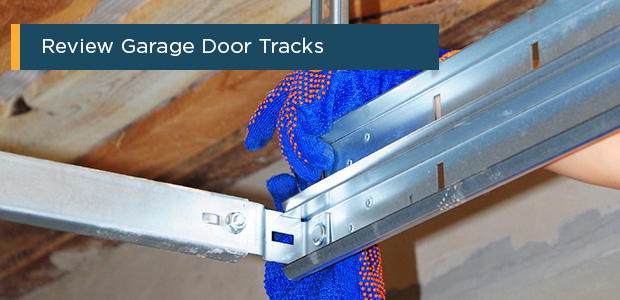
Review the Tracks
Take a quick look at the garage door tracks themselves for bends, breaks, cracks or other damage. If you see something that looks pinched or worn, we recommend you call a technician. This damage may cause your door to get stuck or to fall, both of which are serious hazards.
If nothing looks off, move to one final check of the track and make sure it is plumb. Take your level and place it against the track. Use the top and middle bubbles to ensure the bracket is properly level. If not, unscrew the track support bracket a very small amount. You need just enough slack to move the track a small amount left or right.
Make your adjustments and then place a soft object, such as a wood shim, behind the track bracket. This will help you properly secure and tighten its bolts.
Overhead Garage Door Preventive Maintenance: Lubrication
Grinding metal not only sounds terrible, but it can also lead to a major failure of your garage door. That’s why having lubricant, especially white lithium grease, is a top preventive maintenance tip for garages.
Look up and locate the opener screw or chain. Spray this with white lithium grease for smoother operations. Do this at least once a year for best results.
Overhead torsion springs and extension springs located above roller racks also need a good cleaning. We recommend using a cleaner or lubricant on them twice a year. After spraying, it’s okay to leave the excess on, because it helps your springs have a longer life by preventing some corrosion.
The importance of regular garage door maintenance means a safer, happier home. A good lubrication regimen can keep your door working properly so it doesn’t drop or stick unexpectedly.
Sealed Up Tight
Moisture is a big troublemaker in the South, so keeping it out is part of the best preventive maintenance plan on garage doors. Every year, you should check the weather seal on the bottom of your door for wear or brittleness.
Replace the door whenever you start to see signs of damage or gaps that stay.
On wood doors, you can pry the old seal off with a flat pry bar. Other doors usually feature fasteners and connectors you’ll have to remove.
Make sure the wide angle of the flange is set to the inside of the door when you install a new seal. Replace fasteners or use one-inch galvanized roofing nails to attach your seal. On wood doors, it is best to nail down one side, pull the seal across the door and then nail down the other end. Nailing down the ends can ensure you get a proper fit — just be sure to nail down the middle, placing a nail every three to four inches.
A good seal can keep your door working properly and protect everything in your garage.
Top Preventive Maintenance Tips for Garages: Door Tests
After looking over the innards, it’s time to take a look at your door itself and make sure everything is working properly. Doors come with a variety of safety features and closing options, so be sure to test everything you have.
Regular garage door maintenance is important, so perform these tests at least once a month.
Emergency Reversals
We recommend you start reviewing your door by testing the automatic reversal system, because this needs to be repaired immediately if it is not working properly. For safest operation, it’s recommended you test this system every month.
The reversal system is designed to immediately stop your door from closing if it detects an obstruction. Place a large, solid object in the center of your doorway for this test — we suggest something along the lines of a cinderblock or a 2×4.
When the door comes into contact with the object, it should reverse quickly to prevent damage. If the object is harmed or the door doesn’t reverse, call a professional right away.
The U.S. Consumer Product Safety Commission mandated this system after a review of automatic door openers were found to kill or severely injure at least 85 children over a period of twenty years. While these systems are mandated in each new door, a 2013 review found as many as 40% of emergency reversal systems fail.
Stay Balanced
Balance your door to limit the harm that can come from the door closing on something and to remove gaps in its coverage. A well-balanced door will also perform better on the automatic reversal tests.
To balance your door, disengage the opener with the opener release handle. Lower the door until it is about halfway down the opening and then let go. If your door is balanced, it should rest in this position. Doors with springs that aren’t under enough tension will fall. You can tell door springs are under too much tension if the door rises back up.
Adjusting the tension on these springs can be difficult. If you don’t have experience handling this issue, we recommend you ask a professional for help.
Infrared Checks
Many modern doors use an infrared system to make sure the doorway is clear and the door can close safely. If you have one of these systems, first check to make sure the sensors are no higher than six inches off the ground.
To test the system itself, open your door. Stand near the sensor with a large object and use the remote to close the door. As the door begins to close, move the object back and forth in front of the sensor — this breaks the beam and should cause the door to rise.
If the system doesn’t reverse your door, check your manual for testing and troubleshooting options. We’re happy to come and help if you can’t determine how to adjust the system or if it continues to fail this test even after corrections.
Use the Force, Homeowner
This final door test is one of the top preventive maintenance tips for garages. The force test is one way you can ensure your door won’t close on a person or vehicle.
Perform this test by holding the bottom of your garage door as it closes. If the door doesn’t stop and reverse quickly, you’ll want to adjust the force setting to a lighter number. Each system is a little different, so consult your manual for adjustment options.
Always be sure to test your door a second time after you make any changes to the force setting.
Maintenance Tips for Your Garage Door
Not every maintenance tip we have for you is something that requires checking. Two of our favorite suggestions are one-time installations, but we recommend checking these parts when you do your monthly visual check. These installations can increase your door’s safety for just a few dollars and a few minutes of your time.
Attach Lift Handles
Garage doors straighten and gaps disappear as they close. Hundreds of fingers are caught in doors each year, and that can lead to crushing and even major cuts. The best way to avoid this harm is to install lift handles on the inside and outside of your door. You’ll have an easy place to grab that is designed to be safe for any finger.
One important consideration is to measure the space between your door and the top of your doorframe. If the space is tight, you may need to install a low-profile option.
Install a Containment Cable
Containment cables for spring doors are a great safety option and are one of our top preventive maintenance tips for garage door owners. If your extension spring were to break, it would whip around and cut anything or anyone in the nearby area. This harms hundreds of people each year.
A containment cable for the extension spring is able to prevent this type of activity when your extension spring breaks by stopping the recoil. You’ll spend just a few dollars on each containment cable, making them one of the best safety investments for your money.
Containment cables are bolted to the bracket at the front of your upper rail. Feed the cable through the extension spring itself and then bolt it to the other side. You’re creating a loop of the cable around the spring, and then you can secure it with a washer and locknut. That quick installation is safe for you to do yourself and takes just a few minutes.
Get the Help You Need
When learning how to do preventive maintenance on your garage door, you might come up against problems you can’t fix or don’t feel comfortable tackling. That’s common, and it’s always better to be safe when it comes to mechanics and preventive maintenance on garage doors.
Custom Door & Gate is here to help with any problems or tests you may need. Just use our easy contact page to get more information plus answers to questions about the tests above. If you’re facing a big problem, you can schedule a repair to get an estimate and learn more about repairs or replacements.
And if you’re looking at a door that won’t close or you think may present a hazard to your family, we want you to call us right away, no matter what time it is. We run two 24-hours emergency numbers: 919-524-2818 for homes and 919-369-2113 for businesses.
We know how great a garage door can make your North Carolina home or business look and how scary a malfunction can feel. Custom Door & Gate is here to help.
How to Choose the Right Garage Door
How To Choose The Right Garage Door For Your Home
It’s time for a new garage door, but where do you start? Buying a garage door goes beyond good looks. Size, style, material, and insulation are just a few things to consider when replacing a garage door.
With a little know-how, you can navigate the types of garage doors and the distinguishing features to make your garage safe, well insulated and easy to access.
Selecting a Garage Door Dealer
Starting with a professional garage door dealer makes the entire process of selecting the right garage door much easier and less stressful.
Avoid an unprofessional or inexperienced dealer with these tips:
- Ask friends, neighbors and other local acquaintances for recommendations on garage door companies.
- Check the online reviews for the companies you’re considering. Look for a company with consistently positive reviews. Watch for red flags, including recurring issues that cause customer complaints. An occasional complaint or negative review happens sometimes, but a pattern of issues may be an indication you should choose another company.
- Find a company with years of experience in your area. This long-term experience means the company should understand the specific environmental factors in the area that can impact garage door selection. It’s also a sign the company provides good customer service — a company won’t last long by providing poor service.
- Check into the licensing and insurance the company holds. A reputable company carries commercial insurance coverage and follows all codes and regulations.
- Pay attention to the way the staff treats you. If they provide poor customer service when you’re initially gathering quotes, that quality of service won’t likely improve during the installation.
- Inquire about the services they provide. A quality company should help you through the entire process, from the initial consultation and selection process to installation and beyond.
- Ask lots of questions about garage doors and the installation process. Think of it as a pop quiz for the company. A reputable, qualified garage door dealer should have the knowledge to answer those questions thoroughly.
Choose a Material
The material selection affects not only the look of the door, but also the durability, cost and maintenance. The climate in your area affects the material choice as well.
Narrow down the garage door options by choosing the material that best fits your needs. Consider these primary garage door materials:
Wood
- Provides a classic, natural look
- Traditional styling ideal for Victorian or colonial homes
- Affordable material option
- Variety of wood choices for a custom look
- Choice of stained or painted finish for the style you want
- Option of wood veneers or overlays for lower cost
- Requires regular staining or painting to maintain appearance, making it more work
- Can expand and contract, causing warping and cracking without regular maintenance
Steel
- Strongest garage door material
- Available with embossing that looks like wood grain for a natural look without maintenance
- Stands up to weather elements without warping, cracking or falling apart
- Available finishes to prevent rusting
- Protective finishes to increase longevity of door
- Susceptible to dents
- Sometimes difficult to repair
- Occasional painting may be required, but not often, making it relatively low maintenance
- Opt for 24-gauge steel on a thick door rather than a thinner door with 28-gauge steel — a lower gauge number means stronger, more durable steel
Aluminum
- Made of frosted glass or fiberglass panels within an aluminum frame
- Translucent panels let in more light while still providing privacy
- Lightweight for less strain on the opener and tracks
- Little or no maintenance
- Won’t rust even in humid areas
- Contemporary look ideal for modern homes
- Available in a wide range of styles and colors for greater variety
- More likely to dent, crack or break, decreasing the life of the door
- Can yellow over time, leaving the door looking old or dirty
- Glass resists fading and yellowing more than fiberglass
- Poor insulator
Vinyl
- Lightweight for easy opening and less strain on your system
- No maintenance
- Affordable material
- No rotting or rusting, making it durable and long-lasting
- Resists dents to maintain like-new appearance
- Holds up in salty coastal areas
- Darker colors may fade, so choose a lighter color to keep up the look of the door
- Can look too much like plastic and lack curb appeal for some people — consider viewing the door in person before buying to make sure you like the look
Choose a Basic Type
Construction methods vary from low-end to premium doors. While low-end garage doors typically have only one layer, high-end doors have multiple layers.
Choose from these three basic garage door types:
- Single Layer: At the low end of the range, single-layer doors have only one layer of material. This keeps the cost low, but single-layer doors don’t offer much insulation.
- Double Layer: The next step up is a double-layer garage door with an inner core of polystyrene board for insulation and rigidity. That core is covered by a skin of the primary door material. Double-layer doors offer moderate insulation, usually with an insulating value of R-4 to R-7 — more on the R-value later.
- Premium: The top end of the spectrum consists of doors with a thick polystyrene or polyurethane insulation core with thicker outer layers on either side made of steel, wood or fiberglass. These thicker doors offer superior insulation with values of R-15 or higher.
Single layer doors save you money if the budget is the most important concern. You can find quality garage doors in all three types of garage doors, but opting for a double-layer or premium door offers the extra insulation many homeowners want.
Coordinate the Style and Color
Garage door styles range from simple and basic to intricately detailed doors that fit a particular architecture style. On many homes, the garage door takes up as much as 30 percent of the front façade, so choosing a style that works with your overall home style is important. Use the garage door selection as a way to add some character and style to your home’s exterior.
Take a step back to look at the front of your home. How does your current garage door fit into the overall style? Do you like the overall look, or are you ready for a change? What would you like to change about the style or color of the door to make it a better fit for the look of your home? Do you want the door to blend in with the home’s façade or stand out as a focal point of your home? These factors can help you narrow down the style options.
Possible Style Options
Panel design is one style factor on garage doors. Consider these basic types of garage door panels:
- Flush Panels: This type of garage panel is flat with some light texturing. Flush panel doors are basic and don’t draw a lot of attention. They are available with or without windows.
- Raised Panels: These garage doors feature panels with raised sections as a decorative element. The border around the raised section often has detailing for visual interest. Raised panels give the door depth and have a classic look. Choose between long raised panels, which run the width of the door and short raised panels, which are smaller with several short raised panels in a row.
- Carriage House Panels: An increasingly popular style, these doors look like old-fashioned carriage house doors. They often feature boards crossing at different angles to form the detailing. They may have two handles in the middle and large hinge-like detailing at the sides to look like real carriage house doors.
The style you choose should fit the general architectural style of your home. A Victorian or colonial home deserves a garage door with traditional styling that complements the existing architectural features. Wood construction or a door designed to look like wood creates that classic styling. Divided windows and decorative hardware also fit this style of home, as do the popular carriage-style doors. Avoid modern styles, which look out of place on classic homes.
If you live in a modern home, flex your design muscle with both material and detailing choices. Combining materials, such as wood and steel or aluminum and glass, often produces a modern style. Frosted or pebbled glass is also a fitting option, as is horizontal banding. Look for clean lines instead of ornate, intricate designs.
Ranch-style homes typically feature the classic raised panel style of garage door. Simple designs with horizontal elements work well.
Color enhances the styling of your new garage door and helps it either blend in with the façade or makes the garage door stand out as a decorative element. Choose a color that complements your home’s siding and trim colors. Matching the color to the home’s trim is one way to make the door blend in. White is a common color, but the bright color can make a stark contrast against red brick. A color that matches the mortar helps ease the transition.
If you’re not sure where to start or what would look good with your home, a garage door professional can help you get started. Look for a visualizing tool that lets you try different garage doors on a photo of your home. It’s easy to pick out doors you like in a showroom, but seeing it on your own home helps you find something you’ll love once it’s installed.
Consider Windows
Windows add architectural detailing to your new garage door and let in plenty of light, making your garage feel less like a cave. Most garage doors come with the option to add window panels with decorative frames.
Windows add to the cost of the garage door, but they also add detailing that sets your door apart. The window options come in a variety of shapes and styles, from basic rectangles to intricately detailed curved or starburst design windows. Just like the overall style of the door, choose windows that complement the other design elements on your home.
The placement of the windows is another design factor to tackle. Placement in the top panel adds the beauty of windows and still lets in the light while giving you some privacy in the garage. If you prefer to look out your garage windows, opt for placement in the third panel section up from the bottom of the door. This gives the windows height without making them difficult to reach.
If insulation is important for your garage door, opt for dual-glazed window panels instead of single-glazed panels.
Check Insulation
The garage may not be a living space, but insulation is an important consideration when choosing a new garage door, especially if you have an attached garage. Keeping the garage cool in the summer and warm in the winter can help keep adjacent rooms comfortable as well. Insulation also comes in handy if you use the garage as a workshop. A controlled temperature makes the space comfortable for working.
When evaluating a door’s insulation, look at the R-value, expressed as a number. A higher R-value provides greater insulating powers. A highly insulated garage door helps control temperature and minimizes sounds passing through the door.
Insulation typically comes in the form of a rigid polystyrene or polyurethane foam core between panels of the selected door material. The core makes the door lighter, especially if you opt for a steel door, making it easier and quieter to open and close.
While both materials offer insulating properties, polyurethane insulation generally has a higher R-value and is thinner than polystyrene. For this reason, overall thickness of the door isn’t the best way to determine the insulation quality. Instead, defer to the specs to see which door has a higher R-value.
Evaluate Safety Features
Your new garage door should not only increase your home’s curb appeal, but it should also make your home a safer place. Look for additional safety features when comparing garage doors.
Pinch-resistant doors prevent your fingers from getting smashed between the panels when the door closes. This feature is particularly useful if you have kids, but even adults appreciate it.
The cables that balance the garage door require a great deal of tension to work properly. Messing with that tension is very dangerous for an inexperienced person. Tamper-resistant bottom brackets ensure the tension remains steady by preventing the cables from loosening. These brackets require adjustment sometimes from a trained professional, and this is important as it could potentially prevent serious injury.
Lifestyle Factors
If you have kids, they play a role in choosing your idea garage door. No, you shouldn’t let your kids choose a garage door for you, but if they play in or near the garage, choose an option that stands up to them. A garage door with windows increases the likelihood of broken glass if your kids toss around balls in the driveway. Likewise, a material that dents or cracks easily, such as aluminum, quickly shows signs of wear if your child runs their bike into the door or tosses something at it.
Comparing Brands
The best garage door brands offer a wide range of styles with the quality craftsmanship to back it up. Using quality materials is a sure sign of a respectable garage door company. Positive reviews or designations by third-party organizations also help you spot the best brands.
Clopay® offers several lines of garage doors to fit a range of price points and styles. Consumer Digest named three of those lines — Classic Line Value Series, Classic Wood Collection Series and Reserve® Collection Limited Edition Series — as Best Buy options in August of 2012.
Clopay® aims to manufacture energy-efficient garage doors with low maintenance requirements, along with strength and beauty that make the doors a lasting part of your home. The company ranks as the largest North American garage door manufacturer for both residential and commercial doors.
Sawmill Creek offers custom garage doors in a wide range of styles made with quality woods and materials. The doors feature polystyrene insulation and construction methods that prevent rotting, so you don’t have to worry about deterioration of your new wood garage door. Best of all, the doors come with five and 10-year warranties, providing much longer coverage than many manufacturers.
Look for authorized dealers of the brands you are considering to ensure the quality and selection. For example, Custom Door & Gate is a Master Authorized Dealer for Clopay® garage doors, so we can offer lots of options.
Evaluate Cost
Like any home improvement project, it’s important to go into a garage door purchase with a budget in mind. On average, an installed garage door measuring 16 feet by seven feet costs between $800 and $1,500. On the low end of the range, you can get a composite wood door for around $400 and install it yourself to save money. If you want a custom high-end door, expect to pay $9,000 and up including installation.
The garage door material is one of the biggest factors in the pricing. Here are some general ranges based on material alone:
- Steel: $750 to $3,500
- Glass and Aluminum: $1,500 to $2,000
- Composite Wood: $1,200 to $2,200
- All Wood: $400 to $700 for lower quality; $1,200 to $4,000 or more for high-end
- Vinyl: $900 to $1,500
Several other factors go into the cost, including the detailing on the door. Windows and any extra detailing generally increase the cost, whether you choose a stock door or fully customize the door. Installation by a professional also pushes up the price by $250 to $500.
When pricing your new garage door, ask for a breakdown of costs in the estimate. This lets you see how much goes to the door, installation, automatic opener and any other costs.
Check out the Warranty
Warranties are standard for garage doors, but the length and terms of those warranties vary. Generally, a longer warranty indicates a higher quality door. If something does go wrong, you have the peace of mind knowing the warranty covers the problem.
Check the length of the warranty on each of the brands and styles you consider. Ask to see the fine print to ensure the warranty actually provides quality coverage should something go wrong with the door. A garage door may have a limited warranty with restrictions on what type of damage it covers.
Coordinate Installation
Installing a garage door requires at least two people with some knowledge of home improvement projects. The job comes with danger in the form of the heavy-duty springs that make the garage door function. The process involves mechanical aptitude and many small parts, along with managing the weight of a large garage door. For these reasons, most homeowners leave the garage door installation to the professionals.
Expect the installation to take about five hours — much faster than the average DIY installation. However, the job may take longer depending on the number of garage doors you have installed. Ask your garage door professional for a timeline of the project so you know what to expect.
Be sure to schedule the installation on a day when you don’t need access to the garage, so the installers can get the job done quickly. Professionals ensure the installation gets done properly with a balanced garage door that operates smoothly.
Choose Your Door
Now that you know how to buy a new garage door, check out the options we have available at Custom Door & Gate. Our garage door experts walk will you through the entire process, from selection to installation. We offer a wide range of choices from Clopay® and Sawmill Creek along with our Garage Door Visualizer, so you can find the perfect garage door that fits your style and needs. Contact us today.
Everything to Know About Garage Door Openers
On average, residential garage doors are opened and closed at least 1,500 times per year. Considering how most doors rise from the ground at seven inches per second, the mechanisms that run a garage door opener are crucial to the functionality of a home.
Consequently, a broken garage door opener can be a major problem in need of immediate repair. The following article covers the various things you need to know when you seek out a garage door opener replacement service.
Different Types of Garage Door Openers
Choosing the right garage door openers for your needs and budget requires careful evaluation of multiple factors. You’ll need to select the appropriate drive, which is the mechanism that controls the door’s function. You’ll also want to assess the various control and operational devices available, such as LED lighting and battery backup systems, that enable you to use the door safely during power outages.
Another area you’ll want to explore is whether you want an opener equipped with smart technology, which enables you to operate and control your garage door remotely via your smartphone or tablet.
While there are four basic types of garage door openers, all have one thing in common — they all consist of a motor that moves a trolley. The trolley, in turn, is connected to the door. When the trolley is activated, it causes the door to move up or down. The main difference between the four garage door types is the driving utility. Simply put, some openers run on chains, while others use belts or threaded parts.
Here’s a look at the different types of garage door openers:
Chain Drive
On a chain-driven garage door opener, a metal chain drives the trolley that elevates and lowers the door. Of all the different types of garage door openers, the chain drive option is generally the lowest priced, making it a popular choice among many homeowners. However, chain drive openers can also be noisy due to the movements of the chain. Therefore, chain drive openers can be an inconvenience for noise-sensitive people. Basically, the chain drive is known to be:
- Inexpensive
- Noisy
Chain drives are best for properties where the garage is detached from the house. If you live in a home where the garage is situated directly under a bedroom or living area, you’re probably better off with one of the other options.
Belt Drive
On a belt-driven garage door opener, a rubber belt is used to slide the trolley when the door is activated to open or close. Since the trolley moves over rubber instead of metal, the motions are smoother and quieter. Likewise, a door that runs on a belt drive will produce less vibrations than a door that opens and shuts via chains. Thanks to the reduced number of moving parts, belt drives require less frequent maintenance than chain drives. Essentially, belt drive openers are ideal because they’re:
- Quiet
- Low Maintenance
Belt drive openers are good for any type of house, but they’re especially recommended for homes that feature a garage directly below or beside a bedroom or living area.
Screw Drive
On a screw-driven garage door opener, a threaded steel rod is responsible for the movement of the trolley, which lifts and lowers as the rod rotates. As with the belt drive, a screw drive consists of fewer moving parts, which means fewer problems over the long run. Screw drive openers are also smoother and quieter than chain drives. Like the belt drive, the screw drive opener is known to be:
- Quiet
- Low Maintenance
Also, like belt drives, screw drive openers are ideal for all types of houses. On any property where the living and sleeping quarters are adjacent to the garage, screw drive openers are an especially good option due to the vibration-free smoothness and overall quietness of the whole operation.
Direct Drive
A direct drive opener is the least complicated of all opener types simply because the motor itself is what moves the trolley. Therefore, there’s no belt, chain or threaded piece in the whole operation. Not only does this simplify the process of moving a garage door up and down, but it also results in a smooth, quiet operation that rarely requires maintenance. As such, the direct drive opener is a good option for properties of any size or layout.
The Importance of Horsepower for a Garage Door
Horsepower (HP) is the driving force behind the up and down movements of a garage door. The size and weight of the door can be used to determine the necessary level of horsepower for a particular garage unit. For garage openers, horsepower ratings typically range from 1/3 on smaller, cheaper models to 1 1/2 on higher-end systems. The correlation between HP ratings and door sizes generally works as follows:
- 1/3 HP. A single-car garage door can generally operate on 1/3 horsepower. However, a slightly higher HP will mean usually result in less strain on the opener.
- 1/2 HP. On homes with dual-vehicle, sectional-door garage units, 1/2 HP will usually provide sufficient power for regular opening and closing functions.
- 3/4 — 1 1/2 HP. On larger homes that feature more high-tech garage door openers, horsepower at or above 3/4 is often recommended, especially if the door is used more frequently than average.
The motor of a garage door will run on one of two currents — alternating current (AC) or direct current (DC). The latter is generally the preferable option because DC-powered garage door openers can turn AC into DC power. Moreover, DC motors are smaller in size, as well as smoother and quieter in terms of performance.
Besides the size and weight of the door, consider whether any additional components will increase the strain on the motor and demand more horsepower. Over time the springs may relax, increasing the weight the motor has to move.
Life span is another determining factor when assessing your horsepower needs. If you select an opener with a low rating, you’re more likely to burn out the motor faster and need to replace the device sooner, which is inconvenient and increases your ownership costs.
The Features of a Garage Door Opener
During the course of a garage door opener installation, there is an assortment of features you’ll see. Some of these features could be considered essential and are, therefore, included with most openers.
Other features are generally considered nice to have rather than necessary, so they are only included by request. For modern homeowners, most of the following features can make a garage door opener more convenient in numerous ways:
- Remotes. One of the most convenient things about an electric-operated garage door is that you can activate its movements via remote control. Garage doors are generally controlled via wall-mount buttons or keypads, where you enter a private code that activates the door to open or close. There’s also usually a remote to allow opening and closing from the inside. Additionally, most homeowners use handheld remotes to activate the door externally. Most wall mounts are compatible with single as well as multiple garage door units.
- Manual release. There might be times when you want to raise and lower the garage door manually rather than via remote control. For times like these, there’s the manual release feature, which allows you to disengage the door from its electric mechanisms. This way, you can raise the door to whichever height you need it to be at any given time. For example, if you’re doing work inside your garage that calls for ventilation, the manual release button can allow you to raise the door a couple feet off the ground.
- Security light. Whether you’re coming or going, it’s good to have light from overhead as you walk or drive your vehicle through an open garage door. For added convenience, modern garage doors are usually installed with security lights that automatically power on whenever the door is activated. This way, you can easily see your way inside when pulling your car into the garage after dark. Unlike regular garage lights, the security light will also power off after a few minutes of inactivity.
- Rail segments. The parts of a garage door that comprise its driving functions are attached at a 90-degree angle between the door and the garage ceiling. Most garage door openers include rail segments that fit doors with heights of seven feet. Rail segments generally last for a number of years – as long as corrosion or mishandling doesn’t occur.
- Keychain remote. For remote activation of your garage door from your car or from inside your house, most door openers come with miniature remote devices that can fit into your keychain. When you’re pulling into your driveway, you don’t have to hop out of your car to activate the door — you can use the control attached to your keychain instead. If you don’t enjoy waiting for your garage door to go up, you can even prompt the door to open up from down the block.
- Home automation system. Modern homeowners are increasingly adopting home automation systems, which allow you to control a multitude of prompts, including the garage door, simply by voicing a request. This way, if your kids have been out playing and you want to let them enter the house through the garage door, you could simply say something like, “Alexa, open the garage door,” and the door will open.
- Wi-Fi integration. Another feature that can be added to many of the newer opening systems is Wi-Fi, which makes it possible to control a garage door from anywhere with just a touch of the screen on your smartphone or tablet. Arguably, this is better than a home automation system because Wi-Fi allows you to control and monitor things from anywhere. You don’t even have to be within a certain radius of your property to make this work. If you’re at work and want to check on the status of the door, you can access that information on a mobile app.
- Vehicle compatibility. Certain newer cars are being manufactured with built-in smart technology. As such, these vehicles operate much like smart homes, where lights and doors can be activated by simple touch prompts or voice commands. When you have the prompts for your garage door integrated with the smart technology of a vehicle, you don’t even need a keychain remote because door activation can be prompted from the smart system within your car.
- Auto-close. An auto-close function allows you to pre-program your garage door to be lowered at a certain time, be it five, 10, or 30 minutes later. For example, on hotter days, you might keep your garage door open for a select period of time after you’ve parked and gone inside.
- Soft-activation motors. If you are concerned about the wear that garage door openers endure over time, a soft motor can make operations easier. With a soft-start/stop motor, the door activates with less noise or vibration, which results in less wear and tear as the years go by. As is usually the case, a soft-activation motor can make your garage door last longer and ultimately require less maintenance over time.
- Battery backup. When power lines go down, the experience is more than annoying. When you consider all the electrically powered equipment in your house, a blackout can be a scary prospect. With a battery backup to your garage door opener, you don’t have to worry about the door becoming inoperable if and when the power goes out. If a storm hits your area and a power failure occurs when your door is only half-lowered, the battery backup will complete the closing function. Many of the LiftMaster garage door products we offer include built-in battery technology featuring advanced power management systems and powerful batteries you can trust during emergencies. They will prevent you from having to lift a heavy garage door by hand, reducing the risk of injury.
- LED lights. On certain remote control units, LED lights will activate when problems arise with your garage opener. This allows you to stay on top of any maintenance issues that might develop with the system. Therefore, instead of being caught off guard by failing mechanisms, the problem can be remedied at an early stage – before any damage or repair costs spiral out of hand.
- Rail extension. If you live in a taller-than-average house, an extension can be added to the rail segment that will extend up to eight inches off the ground. This way, a larger garage door is no problem at all. A rail extension can be useful if your house features high walls in the garage, too.
- Jackshaft operators. Designed for use in residential and industrial garages, jackshaft operators work on rolling grilles, doors, and shutters. Produced in light, medium and heavy models, the jackshaft operator can be installed by means of wall mounting, shelf mounting or bracket mounting, preferably just below the door shaft. The jackshaft can be placed on either side of the door, where it allows for maximum headroom. Jackshaft operators are ideal for large garages and for garages where conventional installations would be difficult. These side-mounted openers offer numerous benefits. It won’t obstruct the ceiling, which opens up more overhead room for larger vehicles. You also won’t need to install rails. Maintenance is a breeze, and the side location eliminates worries about lubricant dripping on your vehicles. Finally, you will have more storage space in your garage, which is advantageous for many homeowners.
Safety Features on Garage Doors
With all the advances in garage opener technology, you can get a newly improved system with your next garage door opener replacement. Essential features for any new garage door include motion/object detectors and advanced locking protocols:
- Motion sensors. As the heaviest moving part of your house, the garage door can be dangerous if it lacks motion sensors, which detect when objects pass under the door. That way, you don’t have to worry about the garage door being lowered accidentally onto the hood of your car because the sensor will detect the presence of the vehicle and suspend all motion. More importantly, a motion sensor will protect small children and pets from the dangers of a closing garage door. The functions of a motion sensor are simple. When the door is raised, a laser scans the ground exactly where the door would stand in the closed position. If anyone or anything crosses that path, the motion sensor will activate and stop the door from moving further. Therefore, if a child or dog runs across the door’s path just as the door is closing, the door halts its decline so no one gets injured and nothing gets damaged.
- Locks. Remotes are a convenient thing to have on hand, until you lose them. Whether a miniature remote device slips from your pocket or gets stolen by a stranger, the locking feature of modern garage doors allows you to prevent a missing remote from being used to gain entry into your house. The locking feature will disable whichever access code has been programmed into your remote and can help keep your house safe from potential burglars.
- Rolling code technology. Recent advances in coding technology have made it possible to program garage door openers with rolling codes, which change from one code to another every few seconds. This way, the code within your key fob is fresh every time you use it. This prevents thieves from hacking your fob and gaining access to your house through the garage door.
- Reset features: You can also reset the opener’s code manually. If you have a newer model, the process involves pressing and holding the “learn” button on the central unit, which deletes the old code. You can then test the opener via a handheld remote or another device. An older opener may require using a set of switches located on the central unit and remote.
- Force guard control. If garage door safety and preservation are more important to you than speed, force guard control will slow the door’s movement down to a minimum of force. This means the door uses less energy to raise and lower, and the door also impacts the ground with less force. This can help ease wear and tear along the rail segments and minimize the brunt the door might otherwise face through daily usage over a given span of years.
- Vacation settings. When you’re away from home for days or weeks, it’s good to have the peace of mind in knowing that your garage door is secure. On modern garage door openers, certain settings can ensure the door is locked completely, without exceptions, for the duration of your absence. This renders it impossible for burglars to gain entrance into your home with stolen remotes or hacked codes because all sensors are deactivated while you’re away.
As a further act of precaution, a zip tie can boost the security of the garage door handle. This can prevent thieves from opening your garage door with coat hangers, which could otherwise compromise a door lock within seconds.
When Is It Time to Change the Opener?
Like many mechanical objects, a garage door opener will start to experience issues before it fails. Examples of the warning signs to watch for include:
- Slower movement and eventual detachment
- Loud/unusual noises during operation
- Random garage door opening and closing
- Vibrations
- Garage security issues
Why you Should Hire a Professional for Garage Door Opener Installation
Whether you’re a first-time garage owner or you’re having a broken garage door opener replaced, the installation of an opener can be a huge undertaking. Therefore, it’s important to know what you might be getting into if you consider doing a garage door opener replacement or installation yourself.
That said, it’s always best to hire a professional — someone with experience in handling and testing opener systems — to handle the installation work for you. Here’s why:
- The DIY approach. A residential garage door can weigh as much as 600 pounds, making it crucial to have sufficient manpower to get a door standing properly and synchronized with the tracks. Furthermore, the alignment of rail segments can also involve complicated handy work.
Hypothetically, the only way to successfully carry out an installation as a novice would be to read the instructions thoroughly, several times over, and then take each step slowly with constant double-checking.
Realistically, unless you’re an experienced handyman who easily adapts to various home improvement projects, garage door opener installation work is best left to the professionals.
- The pro approach. The professionals who perform garage door opener repairs and installations on a daily basis know everything there is to know about the fitting and setting of new openers in garage units of all sizes. Whether you request the installation of a single or double-door, seven-foot, or eight-foot opener, they have the proper equipment as well as the experience to safely and correctly install your garage door opener.
Hire Custom Door & Gate for Garage Door Opener Repairs and Replacement Work
The garage door is the largest and often the most vulnerable entrance to a residential home. When you’re dealing with a broken garage door opener, it’s best to have the matter fixed as soon as possible. In North Carolina, residents have long relied on the garage door opener replacement and repair services of Custom Door & Gate.
With over 25 years of experience handling garage door opener installation work, our team has placed new openers into garage units of all sizes. To learn more about what we can do for your garage, contact us today.
The Top 10 Reasons Your Garage Door Won’t Work
As commercial and residential garage door service professionals, we’ve pretty much dealt with every issue you can think of when it comes to garage door repair. Even still, there are sometimes issues that continue to surprise us, like the tiny insect nest growing on the photo eye sensor or the tennis ball that somehow managed to knock the door entirely off its track. Even though these issues are uncommon, it’s nothing that garage door service professionals like us can’t handle!
While there are times you may be able to fix the problem yourself, there are many reasons it may be best to leave the garage door repair up to the professionals. Knowing what’s wrong with your garage door may help you to determine if it is a problem you can tackle or if it’s time to call someone for assistance. To help you troubleshoot your garage door issues, here are the top 10 reasons your garage door won’t work.
1. The Transmitter Batteries Are Dead
This may sound obvious, but your garage door transmitters need power to work. If the batteries in your transmitter are dead, the transmitter won’t be able to send a signal to your garage door to open.
First, check to see if the transmitter on the wall inside your garage still opens your garage door when pressed. If it does, then the transmitter in your car likely just needs a simple battery replacement. If you have more than one car transmitter for your garage door, then your other transmitters will likely need new batteries soon as well, since they were probably installed around the same time.
Changing the battery on your garage door transmitter is pretty simple. On most, you can simply slide the door open on the back of the transmitter and remove the battery. Others may be screwed in to keep the battery more secure, so this type of transmitter will require a screwdriver to open.
After removing the old batteries, make sure the plus and minus signs line up with the plus and minus signs on the inside of the transmitter. Otherwise, the new battery won’t work in the transmitter, and it could give you a false sign that something else may be wrong. Once the battery is in place, test the transmitter, and if it works, replace the transmitter door.
2. Your Photo Eye is out of Alignment
You may remember a time as a kid when you and your siblings would close the garage door and run underneath it as fast as possible to make it out before the door closed. Well, on any garage door installed after 1993, that’s no longer possible thanks to two tiny photo eyes on either side of the garage entrance. These photo eyes transmit an invisible beam between each other that detects if anything is in the garage door’s path when it closes. This safety measure is there to prevent automatic garage doors from closing on top of someone or something and causing serious injury or damage to property.
If you notice that the garage door opens normally but doesn’t make any attempt to close when the remote is pressed, the first thing you’ll want to do is visually inspect the photo eyes. Over time, these eyes can get dirty, causing the light from the beam to be blocked. They also can eventually become misaligned, causing the eyes to not match up on both sides.
When cleaning the photo eye, you should take care not to scratch or damage the eye since it’s made of glass, similar to that of a camera lens. The photo eye itself is pretty small, only a few centimeters in diameter, but it can get dirty rather easily. To clean it, you’ll need a soft cloth and a mild, streak-free cleaner. Gently wipe away any dirt or residue that has built up on the eye and be careful not to oversaturate as excessive wetness can cause dirt to stick to the eye more quickly.
If your photo eyes are clean and the door still isn’t closing, the next thing you’ll need to do is check the alignment of the eyes. The eyes should be pointing in exactly the same direction and at the same angle. If they’re off, they won’t register that the other one is there, and it’ll assume something is in its path, causing the door to stay in the open position. When checking the alignment, measure the height of each photo eye from the ground. Use a level to make sure they’re pointing directly across at each other at the same angle. A laser level will make this part a little easier, but if you don’t have one, a regular level will work as well.
Once you have the eyes cleaned and aligned, test your door to make sure it opens and closes normally. If you’re still experiencing issues with the photo eyes, it may be time to call the professionals to come out and diagnose the problem.
3. The Track is Not Aligned Properly
If your garage door track is out of alignment, it can be a serious issue. The metal track your door runs on needs to be aligned properly in order for your door to move. If you see gaps between the rollers and rail, or bends in the rails themselves, you have a problem. The heavy weight of the door can compound these issues and make them worse until it becomes dangerous to operate your door.
If the track is misaligned, but the door still moves, there are a few things you can do to attempt to remedy the issue on your own. You’ll know that it’s misaligned if you hear a rubbing noise when the garage door reaches a certain spot on the tracks each time it opens and closes. Sometimes the door may even slow down slightly when it hits this spot.
To realign the track, first loosen the screws that hold the track to the frame. Then, gently tap the track with a rubber mallet to move it back into the proper position. Use a level to ensure it’s perfectly straight. Once you have the alignment correct, tighten the screws securely to ensure the track won’t move and cause more issues when opening your garage door. You’ll need to repeat this same process on the other tracks as well, as these may also be out of alignment.
If the door won’t move at all because of an alignment issue, then this problem isn’t one that you should try to tackle yourself. A garage door professional will have the necessary equipment needed to safely realign and repair your garage door. Additionally, if the track misalignment is beyond repair, a professional can install a new garage door track for you.
4. Something is Wrong with your Transmitters
There could be a few issues that might be causing your transmitters not to work properly. The most common reason could be that you’re simply out of range of your garage door. Each garage door and transmitter combo has a specific range it will function in. If you’re trying to open your garage door before you can even see your house, then chances are you’re just too far away. Try waiting until you turn into your driveway to hit your transmitter button, and you should have more success opening your garage door on the first try.
When you know you’re in range and the door still won’t open, check to make sure the antenna is hanging down from the motor inside your garage and nothing is blocking it. Your antenna must be free from any obstruction to clearly receive the signal to open and close the door. Also inspect the antenna for any signs of damage. If it looks like there has been damage to the antenna, you’ll need to call your garage door technician to come out and replace it.
If you find that your garage door opens and closes randomly when you’re not even hitting the button, it may seem like your garage door is going haywire and the only possible solution is to replace the entire unit. However, we assure you that there’s likely a much simpler answer to this problem.
First, make sure your transmitter isn’t stuck under something that could be pressing on the button. For example, your transmitter may have fallen under your car seat and the button is accidentally being pushed by something heavy rolling around on your floor. If that’s not the case, you may also need to check your transmitter’s frequency. It’s possible your neighbors could be running their garage doors on the same frequency as yours, and as they drive by, they’re opening their garage door along with yours.
It’s possible to change your garage door frequency so this doesn’t continue to happen. Each model will have different steps on changing the frequency, so consult your owner’s manual for specific instructions, or call a garage door professional to come help you.
If you’ve tested and tried to remedy these other problems and you’re still having issues, you may need to reprogram your transmitter. All transmitters have a learn button somewhere on the remote, so first you’ll need to locate that on your transmitter. Press and hold the learn button for a few seconds until the indicator light starts blinking. While the light is blinking, press your remote button again to reprogram that remote.
This process may vary depending on your specific garage door model, so you’ll need to double check the owner’s manual to make sure there aren’t additional measures that need to be taken. It should only be a few steps to fully reset and reprogram your remote, though, so your garage door transmitter should be working properly again in no time.
5. Something is Blocking the Door’s Path
As mentioned in issue #2, garage doors are designed with a reversing mechanism that prevents them from crushing objects in their path. If you find that your garage door closes part way and then goes back up, this can be triggered by objects on the ground blocking their path such as garbage cans or toys. It could also be caused by a buildup of debris on the tracks that prevents the rollers from moving forward. This could include small items like rocks, gum or mud buildup. If the door hits even a small object on the track, it will go back up to avoid crushing whatever is underneath it.
Inspect the area around your garage door to see if something is blocking the photo eye sensors. Then look at the tracks to see if there is any buildup on the inside. You’ll need to get a step ladder to look at the tracks on the top part of your garage, as it will be difficult to see from ground level. It may also not be a bad idea to proactively wipe down your garage door tracks periodically to prevent this type of buildup from occurring. Running a damp rag along each track should be enough to remove anything that’s lingering on the tracks.
6. Your Springs are Broken
If your garage door all of sudden won’t go up and you’re sure the transmitters are working properly and power is getting to the motor, then you may have broken torsion springs.
If you happen to be home when these break, you’ll hear a loud bang from inside your garage. This bang can be so loud that some people might think a firecracker went off inside their garage. That’s because garage doors can be very heavy and despite what most people think, it’s not the garage door opener that does the heavy lifting, but rather the heavy-duty springs of the door.
Doors come with one or two torsion springs. If either spring is broken, the garage door opener may struggle to lift the weight of the door or fail to open the door at all. If a spring is broken, call a professional for service as these can be very dangerous to work with. Don’t try to open the door until a professional comes to inspect it and replace the springs. Springs can only be used for a certain number of open and close cycles, and over time they will eventually break and need replacing.
7. The Garage Door Limit Settings Isn’t Set Properly
Sometimes, you’ll notice that your garage door closes all the way and then immediately goes back up instead of staying in the closed position. This issue usually arises with brand new garage doors that were just installed or older models that may need to be reset. If this happens, the most likely culprit is the open and close limit settings of your garage door opener.
This limit range tells the garage door opener how far the door should move before it’s fully closed. If your settings are too high, the door will hit the ground before the opener thinks it should and assume the door is hitting something in its path. It will then automatically reverse to prevent crushing whatever is beneath it.
There are knobs or dials located somewhere on your garage door motor that you can use to adjust the limit settings. The exact location and resetting procedures will vary depending on the brand and model of garage door you have. Your owner’s manual should have more specific information on how to adjust your limits. You may need to experiment with a few adjustments before finally getting the correct setting. If you find that adjusting the limit settings isn’t working, it might be time to call a technician to come and help get your garage door to stay closed.
8. The Disconnect Switch was Enabled
If you can hear your garage door motor running for what seems like the full amount of time it normally would take to open or close the door, but the door doesn’t move, chances are the disconnect switch has been enabled. Every garage door opener comes with a disconnect switch in case you lose power. This allows you to open or close the door manually so your car isn’t stuck in the garage until the power comes back on.
This switch is usually attached to a rope that can be pulled or a knob that can be turned to disconnect. Sometimes, this switch can accidentally come unhooked causing the door to be disconnected from the motor.
However, if you lose power and use the disconnect switch, you’ll need to reattach it to use your garage door motor to open and close your door again. Open the door all the way and then reattach this hook. Then try opening or closing the door again with your transmitter, and you should be all set. It will be easiest to reattach this hook when your car is not in the garage, as you’ll need to place a step ladder underneath the motor to reach it.
9. The Door was Manually Locked
If your garage door doesn’t open, but the opener motor runs for just a few seconds and then shuts off, the garage door itself may have manually been locked. If you’ve checked the door springs and the track for obstacles, and those things appear to be fine, check to see if the lock on the door is engaged.
Quite a few garage doors come with manual locks, especially older models, for added security for your house. These typically look like a knob or handle in the middle of your door with two bars running horizontally from each side. There may be a small button on the top or side of the handle that you can press to slide the bars across the doors, thus locking the garage door from the inside. It can be somewhat easy to accidentally hit that button, especially if you’re getting large objects out of the trunk of your car near the door.
To manually unlock your garage door, simply turn the handle until you hear a clicking sound. This will move the horizontal bars away from the edges and secure the handle in the open position.
10. The Tension Springs or Cables are Broken
Garage doors have tension springs and cables that help to slowly and safely lower your door while closing. If these tension springs or cables break, you might find that your garage door closes really fast, often with a loud bang when it hits the ground. This is very dangerous as there is nothing preventing the garage door from crushing something that might be below it. It’s best to call a garage door professional as soon as you can to have them come out and repair these cables or springs.
Once the springs break, quite a bit of tension is put on the door cables, and they will often break next. When these cables break, they will snap and forcibly fly out like a broken rubber band. Think about how much it hurts to be snapped by a broken rubber band, and then multiply it by a hundred to account for the size and weight of the garage door cables.
Refrain from parking your car in the garage until the garage door is repaired. Additionally, try not to open and close the door while it’s in this condition. With that amount of possible force coming from the springs or cables, they could potentially damage your vehicle or other property in the garage as well as cause serious injury. It’s especially important that you and your family stay away from these cables or springs until everything is repaired.
At Custom Door and Gate, we’ve been installing and repairing garage doors since 1989. We know the ins-and-outs of residential garage door repair, and we can help you diagnose your garage door issues if you’re uncertain what the problem is. We handle everything from automatic garage door repair to garage door replacement. We provide repairs and service to customers in the North Carolina area. Call us today to answer your garage door questions or to schedule a repair with our skilled garage door technicians.
When Is It Time to Change Your Garage Door Opener?
A properly working garage door is vital for the operator to work effectively. Therefore, it is important to test the two mechanisms independently (garage door opener, and garage door) to fully determine the status of the opener.
Garage door openers rarely fail without a lot of warning. If you believe something is not working properly, start by detaching the operator from the door and see if the door operates smoothly and is balanced. This is determined by whether the springs are doing the lifting on the door. Garage door openers are designed to move doors rather than lift them. It is the springs that do the lifting. If you lift a door halfway up the door should stay in place. If it freefalls to the floor there is a problem with the door which can damage the operator.
But, like all mechanical devices, your garage door opener won’t last forever. It also won’t self-improve and keep up with advances happening with garage door opener technology. Garage door safety, security and efficiency have improved leaps and bounds in the past decade. The only way to keep current is to replace your old garage door opener.
Automatic garage door openers have been around for decades. Early models were simple. They had few features other than being able to lift a heavy door up and down several times a day. Over the course of a year, this could be a thousand or more cycles. And over several decades, this amounts to twenty thousand-plus back and forth trips. No wonder they wear out.
How do you know when it’s time for replacing a garage door opener? Usually, it’ll let you know. The signs start when your garage door opener begins operating erratically. It’ll get slow and protest with creaks and groans. The noise gets louder as it gets older.
Understanding these warning signs will pay off. They’ll alert you when to replace a garage door opener before it quits for good.
Signs Your Garage Door Opener Needs Changing
There will be obvious signs your garage door opener needs replacing. The first thing you may notice is your opener starts working intermittently or it ceases to work at all. This can leave you stranded and forced to get out in the dark or in harsh weather to wrestle open a 16-foot, double-wide door by hand.
That’s not good for you and your back. It’s also not fun or always safe. Here are some other sure signs your garage door opener needs changing.
Slow-Moving or Detaching Garage Door Opener
Not all signs of needing a new garage door opener are that sudden. You may find your garage door moving slower when rising. Or worse, it detaches from your opener and freefalls to the floor. That scenario is outright dangerous and could be deadly for children or pets entrapped below. You’ll also notice your opener hesitating. That’s a sure sign it’s tired and ready to check out.
Loud and Unusual Garage Door Opener Noises
Noise provides another huge red flag your garage door opener is ready to pack it in. Older garage door openers seem to be intentionally designed as noisy. Chain drives are especially loud and obnoxious. Rattling drive chains are usually the first thing someone inside your home hears when you arrive home. That’s even before you nose your car up to the garage door.
Slack and vibrating chains aren’t the only noise culprit telling you it’s time for a new one. Electric motors get really loud when they near their end. A garage door motor change will quiet things down. But usually, the entire assembly is shot. The only real remedy is replacing your entire system.
Random and Intermittent Garage Door Opening and Reversing
Opening and suddenly reversing is a common sign of a failing garage door opener. This problem might be with the safety “eye” feature models installed after 1992 were equipped with. But, more often, reversing is due to faulty electronics within the actual opener. Replacing a unit is almost always better than spending the time and money trying to fix an antiquated machine.
Intermittent operation is a common warning your opener is on its way out. You push the remote and nothing happens. You push it again, and maybe it connects. When it gets to half a dozen tries until something finally happens, you know it’s time to call a professional and have your old, outdated garage door opener replaced with a new, high-tech unit.
Noticing a Vibration on a Garage Door Opener
Something else to watch for in a worn out opener is vibration. You’ll see this rather than hear it. Old motors with worn armatures or bent shafts will vibrate inside their housings. If the damage is severe enough, you’ll likely notice the opener mounts shaking loose. That can result in a catastrophic failure where your opener breaks free from the ceiling attachment and falls on the roof of your car.
Security Matters with Garage Door Openers
You expect more than just convenience from your garage door opener. Certainly, you want your opener to operate dependably every time you need it. That goes without saying. But security makes up a highly important part of your entire garage door opener system. Your opener has to keep your door shut and unauthorized people out.
Older garage door openers weren’t designed with the advanced security features today’s new models have. Some manufacturers build security features into an opener. Others become available as options or upgrades. Often, it’s a case of what your budget will allow, but you’ll be pleasantly surprised at what you can get for a few dollars more.
On the other hand, think of the potential loss you can take when your garage door fails to keep burglars out, and they make off with ten times more than a new opener costs. Sure, your insurance might cover some loses, but every claim will affect your premium rates. Plus, your insurance company might require you to replace your garage door opener if it let thieves gain entry.
How Older Garage Door Openers Work
Most older garage door openers were simple. They worked on a system of an electric motor powering a drive that ran along a track hoisting your door up and down. Controls consisted of a wall button inside your garage and, at best, a battery-powered remote control you clipped to your car’s visor. A real luxury was a keyless remote attached to the frame outside your garage.
Those were the good old days. Unfortunately, these old garage door openers weren’t very secure. You could defeat or cheat them easily. Older garage door remotes had a fixed frequency easy to pirate. A simple transmitting device that could broadcast across the radio frequency spectrum your old remote operated on would tell the opener it was time to engage.
Many people who bought townhomes or houses in planned communities weren’t aware developers would purchase and install masses of inexpensive garage door openers to serve their buildings. These older and less-sophisticated homes had garage door openers all operating on a similar remote frequency. Often, one resident would push their remote, and one or more of the neighbors’ garage doors would also rise. Or the doors could dangerously fall if already up.
Enterprising thieves knew this flaw and exploited it:
- They acquired a standard garage door opener remote and drove through communities holding the remote button down.
- They saw what doors activated and noted their addresses.
- Later, these criminals returned when the occupants were away.
- With the flick of a switch, the garage door went up, and the thieves quickly stole inside and out of sight.
If you have one of these old, outdated and mass-produced garage door openers, you should seriously consider replacing it, even if it’s otherwise operating without trouble. Simply exchanging the remote for a more secure device isn’t an option. Remote controls connect to integral receivers built into the opener’s circuit board. You cannot find replacement boards for most old openers, so changing the entire garage door opener is your best insurance.
Rolling Codes and Smart Technology in New Garage Door Openers
Most new garage door openers come equipped with remote control devices that have rolling codes. That means the frequency codes are constantly changing or rolling to a different pattern after each use. This makes hijacking your remote control impossible.
No matter how hard burglars try, they can’t bypass your new garage door opener. Those days of fixed entrance codes are gone. You used to be able to manually set your entrance code into your remote or your opener’s electronics. That’s no longer necessary as technology now does it for you. It’s simpler and far more secure.
Garage door opener technology has also grown smarter. Now you can have a new garage door opener installed that’s compatible with your smartphone, tablet or other hand-held device. That’s another reason to change openers. It’s a sign of the times.
The Many Advantages of Garage Door Smart Technology
Smart technology isn’t just safer. It’s also much more efficient and convenient. From anywhere you can get a Wi-Fi signal, you can operate your garage door. You can check on security when that moment nags and leaves you wondering if you forgot to close the garage door when you left home. You can open your door for a delivery without leaving work and rushing home. You can let in friends or neighbors at your convenience. And you can permanently lock the door for extended vacations.
Smart technology extends to multiple users. Older garage door openers had a single remote control. Second remotes were optional as an added expense and needed to be programmed individually. That was always a hassle. With today’s internet or web-based controls, every member of your family or whoever you like can use their smart device to enter and exit through your garage door.
That’s an exceptional convenience for guests who need temporary access. You no longer have to cut them a key or hide a spare one under the doormat. Now, all you need is to text them a code or have one sent to their device. There’s no way you can do that with an old opener. It’s just one more sign it’s time to install a new one.
Power outages are no longer a concern with today’s smart garage door openers:
- Advanced technology allows for dependable battery backup when the electric grid fails.
- Now when you arrive home in a storm and the power has gone out, you can still remotely activate your new opener.
- It will still respond despite lacking power from your house current.
That smart convenience extends to door opener lights. Once your door is powered by its high-tech battery and headed up, your opener lights will be on and running off the same battery power.
Advancements in battery technology and light developments like LED bulbs allow full brightness as if your power was back on. That’s not just convenient. It’s far safer.
Safety Features in New Garage Door Openers
Some older garage door openers were downright dangerous. The first automated openers closed the garage door regardless of conditions. It didn’t matter if your car was half in or half out. Once the button activated, that door headed down. The only thing stopping it was another manual signal, and that had to trip in the nick of time.
There were many injuries and even fatalities caused by faulty garage door openers when they first became popular. According to the United States Consumer Product Safety Commission (CPSC), in the ten years between 1982 and 1992, 54 children between the ages of 2 and 14 were killed after getting entrapped by falling garage doors. That number of fatalities was intolerable.
The CPSC took action to prevent these terrible tragedies. In 1992, it received Congressional approval to mandate all garage doors must have an electronic eye safety device that “sees” if there’s any blockage under a closing garage door. This allows a safety signal to interrupt and reverse the garage door’s travel. This legislation saved countless lives that otherwise would have destroyed a family.
The CPSC guidelines:
- Allow for light- or laser-activated sensors installed on each side of the garage door and placed slightly above the floor level. Any interruption in the light beam would automatically trip the motor drive and stop or lift the door. That included any misalignment of the beam path.
- Have allowed external entrapment prevention devices to evolve with technology. Now they let owners know of any interruption through their smartphone.
There is another smart safety device recommended by the CPSC, a constant contact control button recommended for households where small children live. Here, the remote deactivates from a one-touch push. The only way a door completely lowers is by the operator keeping constant pressure on the button throughout the down cycle.
Serious Accidents with Garage Doors and Automated Openers
Despite the advancements in smart technology and safety features found in modern garage door openers, accidents still happen far too often with garage doors and their automated openers. This is especially true with older openers you should change for safety’s sake.
The National Electronic Injury Surveillance System collects data on injuries from emergency room statistics. Health Grove tracks yearly household injuries across the United States. They report garage door accidents rank 47th on a list of 77 household injury categories. Their statistics report that on average, 10,580 injuries occur each year caused by garage doors. Here’s a year-to-year rundown on garage door injuries:
- 2005 — 10,171
- 2006 — 8,329
- 2007 — 10,220
- 2008 — 10,119
- 2009 — 10,258
- 2010 — 12,201
- 2011 — 11,200
- 2012 — 9,349
- 2013 — 9,656
- 2014 — 9,094
- 2015 — 17,282
No, that’s not a misquote or typo error. In 2015, the number of garage door accidents rose an astonishing 90% over the previous year. It’s also a 63% increase over the entire ten-year injury average. What was going on?
Behind the Spike in Garage Door Injuries
Speculation points the blame at a sudden increase in faulty garage door openers. With the rebound in the American economy and rise in home building and renovations, many track builders and homeowner do-it-yourselfers installed inexpensive garage door openers from big-box suppliers. These cheap knock-offs were not certified for safety by the Underwriter Laboratories (UL) Standard for Safety.
This attempt at cutting a few dollars off a building, renovation or home garage door opener replacement caused a serious spike in household injuries. It certainly makes you think twice about what appears to be a good deal and not having your new garage door opener professionally installed.
Many of these injuries were avoidable. Fortunately, very few garage door accidents resulted in death. Most of the injured received treatment in the emergency department before release. Unfortunately, a significant number were hospitalized and left with permanent disabilities. And, sadly, many of these unfortunate mishaps were preventable.
Installing a safe and dependable new garage door opener offers the best way of preventing a garage door injury. It also provides the best form of security against burglary, theft and vandalism. Perhaps now is time to change your garage door opener for a new one.
Turn to Custom Door & Gate for Professional Garage Door Opener Installation
If you want to protect yourself, your family and your belongings, Custom Door & Gate can help. We’ve served the Raleigh, Greenville, Greensboro and Fayetteville areas of North Carolina since 1989. Our expert staff has over 100 combined years professionally installing garage door openers and other products.
We’re accredited by the Institute of Door Dealer Education and Accreditation (IDEA). We’ve received Clopay’s Top Presidential award for garage door installation as well as LiftMaster’s Provantage dealer recognition. Our technicians are proud to be trained and qualified to install products from these top manufacturers.
Custom Door & Gate installs all types of garage door openers. Choose from our economical but safe and reliable chain drive models. Have a whisper-quiet belt drive garage door opener installed to keep noise from interfering with an adjacent bedroom or home office. You can also purchase an advance screw-type opener that’ll give you years of trouble-free operation.
At Custom Door & Gate, we also offer exceptional value in high technology.
You’ll know when it’s time to change your garage door opener. Now you know your best value comes from calling Custom Door & Gate to get your garage door dependably up and down. Contact us today for assistance choosing the right residential garage door system for you.




